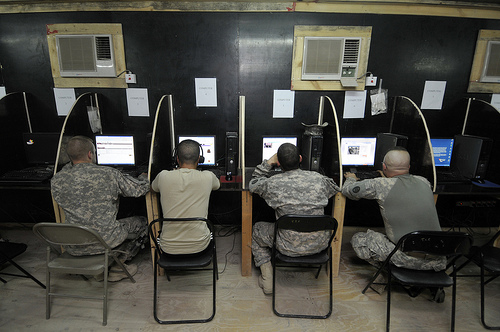Intersecting Parallel Universes – Online Learning and Military Voluntary Education
Published by: WCET | 2/22/2012
Tags: Completion, Credits, Military And Veterans, Online Learning, State Authorization
Published by: WCET | 2/22/2012
Tags: Completion, Credits, Military And Veterans, Online Learning, State Authorization
Last week the Council for College and Military Educators held their annual symposium and as an attendee and concurrent session presenter, I had the opportunity to observe the many conversations those in the military voluntary education community are having that parallel and intersect with those we’re having in the online education community. One surprise for me was that by the time a military student completes a credential they have attended on average 5 institutions to compile all of the credits necessary and often times graduate with far more credits than are necessary for the degree because all of those credits don’t fit the degree requirements. To me, that speaks to a necessity to reconsider our general education requirements, so that they are more broad to allow a greater diversity of credits to be accepted, thereby reducing the burden on the student and the tuition assistance/financial aid system.
My observations:

Military students choose online education for convenience. During Tuesday’s Military Student Panel, all five students (representing the Army, Navy, Marines, Air Force and Coast Guard) echoed that the primary reason they take online classes, even those who preferred the face-to-face interaction, was for their convenience. This becomes even more imperative if they are studying while deployed. An interesting take away for online educators, when deployed, connectivity can be spotty and slow. While they see the value in the bells and whistles (embedded graphics, videos, etc.), they often don’t have the bandwidth to take advantage of these. This also goes for completely online textbooks – while deployed they may not have the computer time or bandwidth to utilize these resources.
Considering the overlap in our student populations, how, or are, your online programs serving military students? I would love to hear about your best practices for serving online military students in the comments.
Cali Morrison
Manager, Major Grants, WCET – WICHE Cooperative for Educational Technologies
Project Director, Transparency by Design
cmorrison@wiche.edu
Photo by Petty Officer 2nd Class Edwin L. Wriston, Creative Commons Licensed by The U.S. Army on Flickr.
2 replies on “Intersecting Parallel Universes – Online Learning and Military Voluntary Education”
Cali, I found your observations most interesting and wish I had been there. I directed Navy Voluntary Education from 1976 to 1999-22 years and was instrumental in bringing educational technology into the program…Navy was first to do this but I remain concerned that so great a proportion of the delivery is on-line…many military students need assistance with programs and while on-line is popular primarily because it is so convenient…there are many issues. Wish you and I could talk sometime.
Posted on behalf of Brian Sayler, Military Affairs, Kaplan University:
There is definitely a lot of work to be done in voluntary education. Transfer credit was a big theme this year at CCME and it has always been an area where military students often suffer. The admirable efforts of service members who take courses whenever they have opportunities be it on base, at a local college or via distance learning often find those credits are difficult to transfer. Organizations, such as SOC have attempted to bridge this gap, and member schools are required to accept credit from other member schools. The military has also supported getting ACE recommendations for various training courses and occupations. However, it less than a perfect system and in many cases the incredible learning experiences and training our military members achieve goes unrewarded.
At Kaplan University, we’ve provided a great deal of focus on how we support our military students. In regard to military transfer credits the key is to be proactive in seeking out military programs, or helping student uncover hidden credits.
We accept training when validated through CLEP or DSST; we accept credit from other SOC member or accredited institutions. We work to be included into the SOC Degree Network System where required credits are mapped to all other DNS institutions. Currently we are pending circulation in 9 programs. We also offer a program that allows students to build a portfolio based on their military, community service, or personal experiences which have not been validated by other means. They are assisted in determining the realized outcomes from these activities and matching those against courses from accredited schools. We allow student to bring in up to 75% of credits either by experiential or transfer credit. We participate in the Air Force’s Associate’s to Bachelor’s Cooperative Program (AUABC) which is essentially a 2 plus 2 program with the Community College of the Air Force. We participate in the Air Force’s General Education Mobile, which helps Airmen obtain their general education electives online paving the way for achievement of the associate’s program through a mix of training and other college courses.
Another key step for KU was to insure our programs provide adequate room to be flexible in regard to open electives. Many times experiential credits or credits earned by examination do not satisfy key requirements. Therefore all bachelor’s programs offer 59 credits, approximately 32%, in the form of open electives. Another by product of this approach is it also is more forgiving of course corrections early in a student’s career and allows them some latitude to pursue special interests.
I think what CCME’s annual symposium brings to light each year is that institutions really need focus if they are going to emerge with the effort needed bridge these types of gaps. Often military support departments are small and don’t receive the attention of senior administrators. Some of that will change with the new MOU that all schools using TA must sign but we need to keep surfacing the issues and looking for creative solutions.